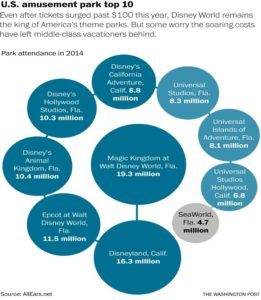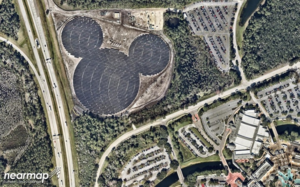The Mouse Versus Mother Nature

Disney and Climate Change? What does an entertainment company have to do with the environment?
The Walt Disney Company has a long history of committing to reduce its carbon footprint to help save the environment. With a growing tourism business in theme parks, there is tension between investing in environmental programs and maximizing profits considering how large the investment would need to be. Mother nature is unpredictable with hurricanes that cause disruption in guests’ vacation plans or damage property.
In 2015, the Mouse announced, “By 2020, Disney will reduce net emissions by 50% from 2012 levels by following the hierarchy of avoiding emissions, reducing emissions through efficiencies, and replacing high-carbon fuels with low-carbon alternatives” [1]. The company’s theme parks and hotels and resorts consume an enormous amount of energy. Just in Orlando, Disney owns 4 theme parks, 2 water parks, and 27 hotels [2]. The four theme parks in Orlando are all in the top 10 U.S. amusement park attendance list seen below [3].
[3]
“Greening” the Resort
To help in the reduction of demand for energy despite a growing tourism business at Walt Disney World, Disney must look to innovative ways of energy conservation.
Outside Partnerships
Disney has been considering alternative sources of power to move towards energy sustainability. Recently in 2015, Disney has partnered with Duke Energy Corp to use solar polar to produce energy to run its theme parks. The solar facility will be 20 acres with 48,000 solar panels [4]. Angie Renner, of Disney World, states, “this new solar facility will help us in our efforts to conserve natural resources” [4].
Trash as you might expect comes to the resort’s landfill in large quantities each day. Disney World’s landfill is reserved for 100 tons of solid waste delivered daily [5]. Looking for a solution to keep waste storage and odor to a minimum, Disney partnered with local start up, Harvest Power, to use a portion of their waste to create biogas that is sold back to Disney as renewable energy [5]. Programs like these not only bring distinction to Disney’s environmental programs and commitment, but also help reduce its operational costs.
[5]
Internal Programs
Promoting collaboration and competition among employees to reduce energy costs has been a success. A primary example is the trains in both the Magic Kingdom and Disneyland run on bio-diesel fuel made from recycled cooking oil that is retrieved from each resort’s activities resulting in reducing 200,000 gallons of petroleum diesel used each year [6]. These types of results have increased the employee participation to make real contributions to decrease operational costs. It’s a way to be recognized and install a sense of pride within departments to compete with one another while driving innovative ways to inspire cast members to consider carbon emissions in their day to day activities.
In 2008, Walt Disney World achieved a 100% scorecard for its hotel properties in achieving the Green Lodging Program designation. Governor Crist of Florida said, “I applaud Disney’s compelling participation in the Florida Green Lodging Program. Disney is demonstrating the importance of environmental stewardship to thousands of employees and millions of guests” [7]. How did they achieve this? With 440,000 square feet of conference space and 50,000 hotel rooms, a little here and there goes a long way [7]. Programs such as timers on lighting, figuring out the most efficient use of lighting, a towel reuse program, installing low-flow faucets, and implementing a paper and can recycle program [7].
Mickey saves the day?
Given that the Walt Disney World has been around since 1971 and many of the properties are over 50 years old, to achieve a strategy of complete independence on traditional energy sources is not realistic. However, the Company is committed to taking small steps each year to reducing consumption and emissions across all operations. The vastness of the properties means that guests rely on buses to transport them between theme parks. Could Disney expand the monorail between theme parks? An investment in regenerative braking systems would result in 25% savings in power usage [8]. This would be an environmentally friendly mode of transport compared to guests continuing to drive in cars. An extensive monorail system among the parks although is not likely; it would be a long term huge capital investment and would have the net effect of a significant reduction in parking revenue.
Disney has the unique opportunity to influence the next generation of energy consumers as they have world renowned characters – Mickey Mouse, Elsa, Cinderella (the list is endless). This provides a unique opportunity to educate children as to the importance of energy sustainability and conservation. Today, Disney IP is used to teach children to code, why not teach children about climate change? Using a character such as Elsa to teach about the merits of recycling and turning the lights off are messages children will absorb.
Where does Disney go from here?
(800 Words without citations)
Citations
[1] “FACT SHEET: WHITE HOUSE ANNOUNCES COMMITMENTS TO THE AMERICAN BUSINESS ACT ON CLIMATE PLEDGE – OCTOBER 19, 2015,” press release, October 19, 0215, on White House Website, http://www.whitehousepressbriefings.com/other-releases/fact-sheet-white-house-announces-commitments-to-the-american-business-act-on-climate-pledge-october-19-2015/, accessed 2016.
[2] Walt Disney Company. “Walt Disney World.” https://aboutdisneyparks.com/about/around-the-world/walt-disney-world, accessed November 2016.
[3] Drew Harwell, “How theme parks like Disney World left the middle class behind,” The Washington Post, June 12, 2015, https://www.washingtonpost.com/news/business/wp/2015/06/12/how-theme-parks-like-disney-world-left-the-middle-class-behind/, accessed November 2016.
[4] “Duke Energy Launches New Solar Facility at Walt Disney World Resort,” press release, April 12, 2016, on Duke Energy Website, https://news.duke-energy.com/releases/releases-20160412, accessed November 2016.
[5] Beth Kowitt, “Could your child’s uneaten broccoli help provide electricity?,” Fortune, September 9, 2015, http://fortune.com/2015/09/09/harvest-power-kathleen-ligocki/, accessed November 2016.
[6] David Gill, “Every Role a Starring Role – Disneyland Railroad Steam Trains Fueled by French Fry Oil,” Disney Parks(blog), Disney Parks, April 12,2011, https://disneyparks.disney.go.com/blog/2011/04/every-role-a-starring-role-%E2%80%93-disneyland-railroad-steam-trains-fueled-by-french-fry-oil/, accessed November 2016.
[7] Source: GOV. CRIST APPLAUDS COMPLETION OF GREEN LODGING CERTIFICATION AT WALT DISNEY WORLD RESORT, via Factiva, accessed November 2016.
[8] Source: NBM & CW, “Monorails Redraw Travel Lines,” Athena Information Solutions Pvt. Ltd., 2014, ABI/INFORM via ProQuest, accessed November 2016.






This is a great read on the sustainable practices that Disney is already focused on! How would you compare their practices with competitors?
While I do think Disney is ahead of most in the tourism industry in conserving energy, they continue to invest in construction that isn’t necessarily the most sustainable. I think there is a lot of opportunity for Disney to focus their sustainability initiatives on their new construction projects to truly be a leader in sustainability. For example, they could invest in materials are have the least impact on the environment, or low-energy construction practices.
I also would push whether Disney needs to continue to always build or re-build their rides – which uses a l lot of resources, energy, materials, and waste. I’m curious to see whether all the energy they are saving from day-to-day operations is more than the energy they are using from continued renovation.
Thanks for the great intro to efforts under way at Disney to reduce its carbon footprint. I was especially intrigued by the Mickey solar power project with Duke Energy in Orlando. It’s a great first step, but as this Forbes article points out, accounts for a “mouse-sized” portion of power used, i.e. roughly $500,000 (10.5M kilowatt-hours per year) in the first year, compared to a whopping $84 million worth of electricity consumed by Disney’s theme parks and 40,000 hotel rooms in the area. As Disney increasingly incorporates sustainability into its business and operational plans, what additional measures will it adopt? Could it leverage its location in sunny California and Florida to expand solar and other renewable energy production initiatives? What types of economic and tax incentives can local and state governments implement in order to facilitate such corporate investments?
http://www.forbes.com/sites/christopherhelman/2016/02/29/disney-world-taps-solar-power-with-mickey-mouse-pv-project/#771e544851e9
Thanks, Marissa – very interesting post! I wonder if Disney may have an opportunity to also partner with an airline(s) that is focused on climate change initiatives, given that so many people fly to reach Disney’s theme parks. I think this could signal to the public that Disney is thinking about its impact on the environment both directly and indirectly. Something as simple as a Disney rewards program with a given airline, with the climate change efforts of both companies explicitly highlighted, could be beneficial for both companies.
I am quite impressed by what Disney has and continues to do to reduce it’s carbon footprint. Most companies seem to struggle with this tradeoff between profitability and sustainability and Disney is no exception as you brilliantly point out in your monorail expansion versus parking revenue example.
The idea about using their characters to educate children about energy sustainability is great. I want to take that a step further and focus on merchandise. I know as a kid, I would always guilt my parents into buying me merchandise from the gift shop. I think there is an opportunity to improve here – by using sustainable material for their shirts, stuffed animals and other toys. I am curious as to how big of an effect this will have on operations? (assuming it’s not already being done)